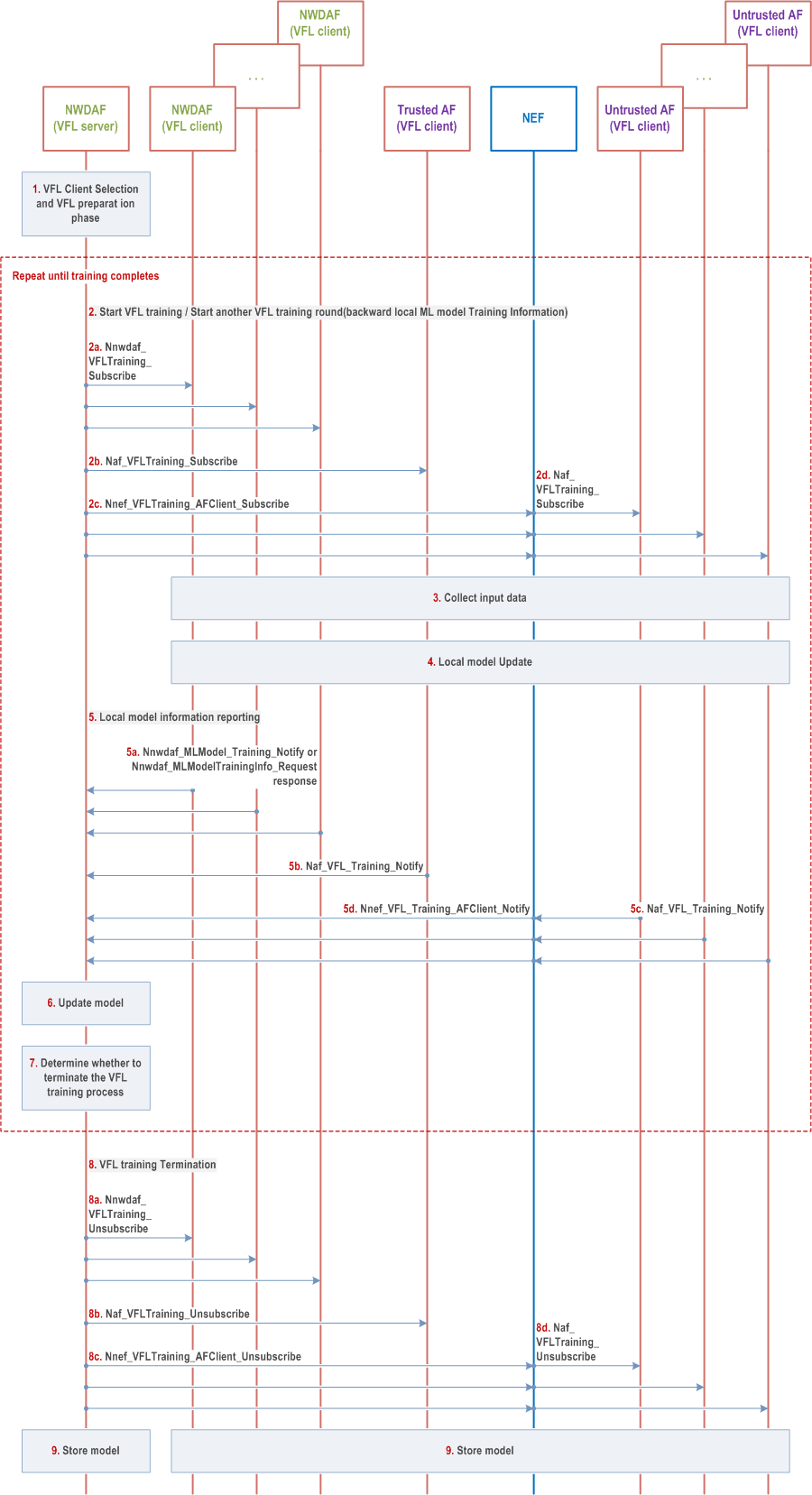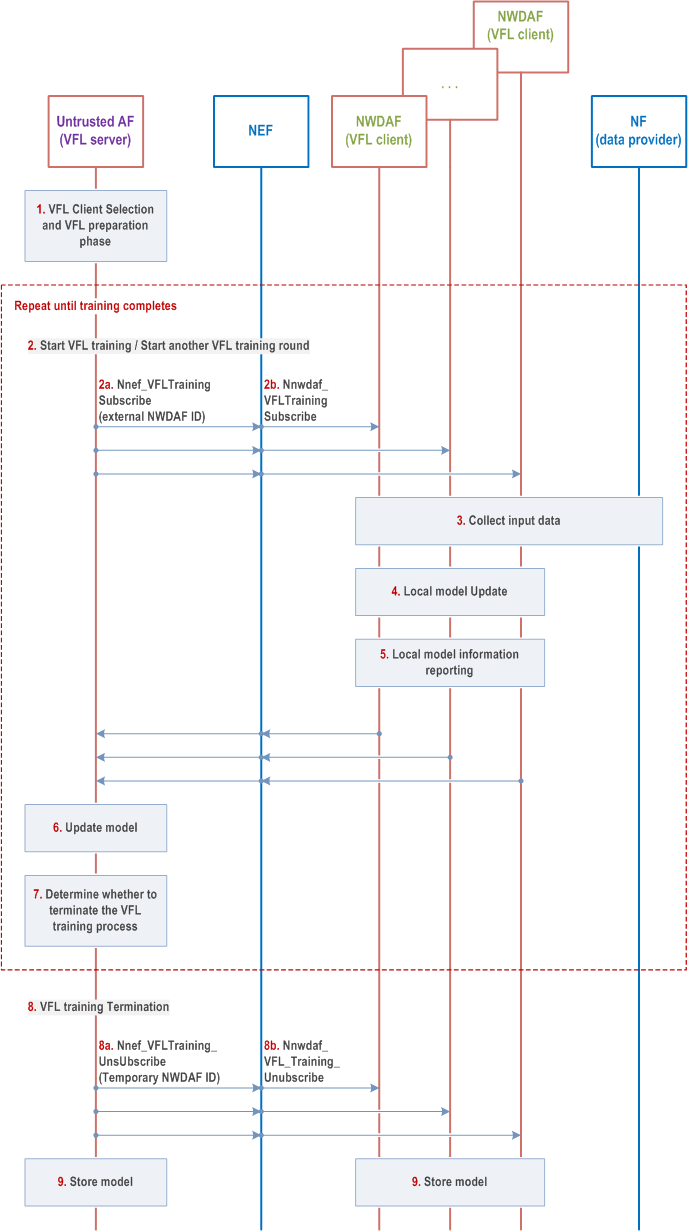Content for TS 23.288 Word version: 19.1.0
1…
4…
5…
5A…
6…
6.1.3
6.1.4…
6.1.4.4…
6.1.5…
6.1A…
6.1B…
6.1B.2.3…
6.1C
6.2…
6.2.3…
6.2.6…
6.2.6.2
6.2.6.3…
6.2.6.3.3
6.2.6.3.4
6.2.6.3.5
6.2.6.3.6…
6.2.7…
6.2.8…
6.2.9…
6.2.13…
6.2A…
6.2B…
6.2B.3
6.2B.4…
6.2C…
6.2D…
6.2E…
6.2F…
6.2H…
6.2H.2.2…
6.2H.2.3…
6.2H.2.4…
6.3…
6.4…
6.5…
6.6…
6.7…
6.7.3…
6.7.4…
6.7.5…
6.8…
6.9…
6.10…
6.11…
6.12…
6.13…
6.14…
6.16…
6.17…
6.18…
6.19…
6.20…
6.21…
6.22…
6.23…
7…
7.4…
7.7…
7.9…
8…
9…
10…
6.2H.2.3 Training Procedure for Vertical Federated Learning
6.2H.2.3.1 Training Procedure for Vertical Federated Learning when NWDAF is acting as VFL server
6.2H.2.3.2 Training Procedure for Vertical Federated Learning when untrusted AF is acting as VFL server
...
...
6.2H.2.3 Training Procedure for Vertical Federated Learning p. 168
6.2H.2.3.1 Training Procedure for Vertical Federated Learning when NWDAF is acting as VFL server p. 168
The Figure 6.2H.2.3.1-1 below shows the training procedure for Vertical Federated Learning when NWDAF is acting as VFL server.

Step 1.
Steps 2-6 are repeated until the training termination condition is reached.
The NWDAF acting as VFL server determines the VFL clients that participate in VFL procedure in the VFL clients discovery and preparation phase as described in the clause 6.2H.2.1 and clause 6.2H.2.2.
Step 2.
To start the VFL training, the VFL server sends a request to start the training to all selected VFL clients The request includes VFL correlation ID, at least the parameters negotiated during the preparation phase, Optionally, the VFL Server includes: Analytic filter information, maximum response time (i.e. the maximum time between VFL clients receive intermediate model training information and send back intermediate training result).
If the VFL procedure continues in subsequent iterations, the VFL server sends a request for a new VFL training iteration containing the VFL correlation ID and intermediate model training information to each of the VFL clients for next round of VFL training.
Step 2a.
The VFL server sends a Nnwdaf_VFLTraining_Subscribe to the selected NWDAF VFL clients(s).
Step 2b.
The VFL server sends a Naf_VFLTraining_Subscribe to the selected trusted AF VFL clients(s).
Step 2c.
For each selected untrusted AF VFL clients, the VFL server sends a Nnef_VFLTraining_AFClient_Subscribe to the NEF handling that AF.
Step 2d.
For each selected untrusted AF VFL clients, the NEF sends a Naf_VFLTraining_Subscribe to that AF. The NEF may also translate the analytic filter information if needed, e.g. TAIs into geographical area.
Step 3.
[Optional] Each VFL client collects its local data by using the current mechanism if the VFL client has no local data already available. The data used by each VFL Client is collected as per alignment information.
Step 4.
During VFL training procedure, each VFL client further trains the local ML model associated with the same VFL Correlation ID based on their own collected or available data and when applicable (e.g. after the first round of training) and possible intermediate model training information distributed by the VFL server in the previous training iteration. Each VFL Client computes and reports the client intermediate training result of the local ML model to the VFL server.
Step 5.
Each VFL client reports the computed client intermediate training result of the local ML model to the VFL server.
Step 5a.
A NWDAF VFL client sends a Nnwdaf_VFLTraining_Notify .
Step 5b.
A trusted AF VFL client sends a Naf_VFLTraining_Notify to the VFL server.
Step 5c.
An untrusted AF VFL client sends a Naf_VFLTraining_Notify to the NEF.
Step 5d.
For each untrusted AF VFL client , the NEF converts any external identifiers to internal identifiers and sends a Nnef_VFLTraining_AFClient_Notify to the VFL server.
Step 6.
The VFL server may collect the local data and generate its own local intermediate training result. The NWDAF acting as VFL Server computes the intermediate model training information (e.g. gradient information or loss information) based on the VFL Client(s) intermediate training result(s) received in step 4, its own local intermediate results and the label. The intermediate model training information is used for updating the models of VFL clients. Different intermediate model training information may be computed for different VFL clients and for the VFL Server itself.
The VFL server may also compute the ML model metric (e.g. ML model accuracy) based on all the intermediate training result received from VFL clients and the label.
Step 7.
[Optional] The NWDAF acting as VFL server evaluates (e.g. based on the convergence of a loss function or loss value and/or if the pre-set iteration number is reached) whether VFL Training process converged. If the VFL Server evaluates the VFL Training process did not converge, the NWDAF acting as a VFL Server determines another round of VFL training is required and repeats step 2 - 6. If the VFL Server evaluates the VFL training process converged, it determines the VFL Training is completed. In this case, the VFL Server terminates the current VFL training process via step 7.
The VFL training termination decision may be also made as follows:
Based on the consumer request, the VFL server sends VFL status report to the consumer. The status report may include model metric (e.g. ML model accuracy).
The consumer decides whether the current model can fulfil the requirement, e.g. ML model metric is satisfactory for the consumer and determines to stop or continue the training process. The consumer continues the training process or stops the training process.
Based on the subscription request sent from the consumer, the VFL server updates or terminates the current VFL training process.
Step 8.
The VFL server sends VFL training termination message to VFL Client if it decides to terminate the VFL training process, the termination message contains VFL Correlation ID.
Step 8a.
The VFL server sends a Nnwdaf_VFLTraining_Unsubscribe t to the selected NWDAF VFL clients(s).
Step 8b.
The VFL server sends a Naf_VFLTraining_Unsubscribe to the selected trusted AF VFL clients(s).
Step 8c.
For each selected untrusted AF VFL clients, the VFL server sends a Nnef_VFLTraining_AFClient_Unubscribe to the NEF handling that AF.
Step 8d.
For each selected untrusted AF VFL clients, the NEF sends a Naf_VFLTraining_Unsubscribe to that AF.
Step 9.
The VFL Server, stores VFL correlation ID, the local trained ML Model, the mapping information of the VFL correlation ID to the following parameters: Analytics ID related to the VFL training process, locally trained Model. Additionally, the VFL server stores the VFL client information, which may be used to determine associated VFL client in the VFL inference.
Each VFL client stores VFL correlation ID, the locally trained ML Model, the mapping information of the VFL correlation ID to locally trained Model
6.2H.2.3.2 Training Procedure for Vertical Federated Learning when untrusted AF is acting as VFL server p. 172

Step 1.
Steps 3-7 are repeated until the training termination condition is reached.
Same as step 1 in Figure 6.2H.2.3.1-1.
Step 2.
To start VFL training, the VFL server do same as in step 1 in Figure 6.2H.2.3.1-1, using Nnef_VFLTraining_Subcribe .
Step 3.
[Optional] Same as step 3 in Figure 6.2H.2.3.1-1.
Step 4.
Same as step 4 in Figure 6.2H.2.3.1-1.
Step 5.
Same as step 5 in Figure 6.2H.2.3.1-1.
Step 5a.
A NWDAF VFL client sends a Nnwdaf_VFLTraining_Notify .
Step 5b.
For an untrusted AF acting as VFL server, the NEF converts any internal identifiers to external identifiers, provides the external NWDAF ID and sends a Nnef_VFLTrainingNotify to the VFL server.
Step 6.
[Optional] Same as step 6 in Figure 6.2H.2.3.1-1.
Step 7.
Same as step 7 in Figure 6.2H.2.3.1-1.
Step 8.
Same as step 8 of Figure 6.2H.2.3.1-1. However, sub steps in that Figure are not applicable.
Step 8a.
For each NWDAF VFL client, the untrusted AF as VFL server sends a Nnef_VFLTraining Unsubscribe to the NEF handling that AF. The untrusted AF identifies the VFL client using the external NWDAF ID assigned in the discovery procedure (see clause 6.2H.2.1.1).
Step 8b.
The NEF sends an Nnwdaf_VFLTraining_Unsubscribe to the NWDAF VFL client indicated by the received external NWDAF ID.
Step 9.
Same as step 9 of Figure 6.2H.2.3.1-1.